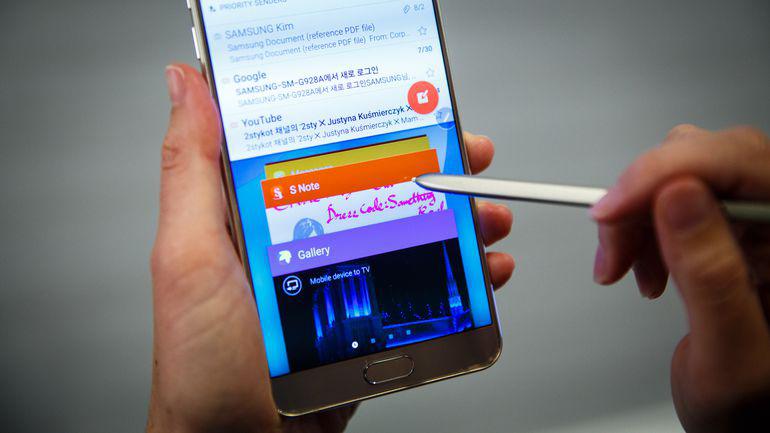Troy Wolverton: Lithium battery dangers mean Samsung recall won’t be last
The Samsung Galaxy Note 5 has an eye-catching design, high-end hardware and takes great outdoor photos. Using the stylus has never felt better, and battery life is terrific. (Handout/TNS)
October 20, 2016
By Troy Wolverton
A faulty battery has cost Samsung a pile of money and tarnished its reputation.
But the Korean electronics giant wasn’t the first company forced to recall a product due to batteries that had a tendency to catch fire — not by a long shot. And it almost certainly won’t be the last.
That’s because the same type of batteries that powered Samsung’s now-recalled Note 7 smartphone are used far and wide not only in mobile devices, but also in a wide variety of other products including, increasingly, in things like cars and homes. And that battery type — lithium ion — is inherently dangerous, potentially getting more so and almost certainly won’t be replaced anytime soon.
“For the foreseeable future, we’re stuck with lithium ion,” said Werner Goertz, a research director who focuses on battery technology at Gartner, a technology industry consulting firm.
Lithium ion batteries first hit the market in the early 1990s. The technology promised portable devices that were lighter and could last longer on a charge than those that ran on older types of battery chemistries. Those advantages are largely due to lithium itself, which is the lightest metal in the periodic table. That physical advantage allows manufacturers to pack a lot of energy into small, lightweight forms.
Lithium batteries have largely met their promise. Thanks to such batteries, you can have the equivalent of a high-powered computer in your pocket that can last all day without needing to be plugged into an outlet. As production has grown and the batteries have become less expensive, they’ve started to displace older battery technologies like nickel-metal hydride and lead-acid batteries in cars, home phones and other products.
The vast majority of the lithium batteries in use never cause a problem.
“Fundamentally, the technology is safe and is widely used in billions of phones,” Goertz said.
But lithium-ion batteries do have a hidden hazard. Lithium itself is highly combustible and batteries made with it are subject to “thermal runaway.” If they get too hot, they can catch on fire, which increases heat, which helps the fire to spread and burn even hotter. That chain reaction can be triggered by poorly designed or manufactured batteries or devices. Or it can be set off by damage to the battery. Preliminary reports indicate the Note 7’s problems stem from a manufacturing flaw that pushed together the positive and negative cells of the battery, causing it to overheat.
Battery and electronics manufacturers take numerous steps to try to mitigate such dangers. Device makers engineer their products to dissipate heat via fans, liquids or other heat conducting materials. Devices often have temperature sensors that can shut off power or turn off certain functions in case of overheating. There are chips that regulate the amount of electrical power going into the batteries when they’re recharged to make sure they don’t overheat. And there are circuits inside the batteries themselves which can automatically turn off to prevent fires.
But while the industry has tried to make lithium-ion batteries safer, “the technology itself isn’t foolproof,” said Ravi Manghani, director of energy storage research at GTM Research.
Samsung learned that the hard way with the Note 7. After the first reports that some of the new phones were catching fire, the company issued an initial offer to swap out the phones. Then reports came in that even some of the replacement models were going up in flames.
After more than 90 reports of fire incidents, the company ceased sales of the model worldwide and issued a recall of 1.9 million devices sold in the United States alone. All told, the company now estimates the recall will cost it at least $3 billion.
But Note 7 is only the latest in a long-line of devices undermined by faulty lithium-ion batteries.
Since June of this year, educational toy company Roylco recalled 1,400 light tables designed for kids. Home audio company Denon recalled a rechargeable battery designed for its wireless speaker systems.
Lekker recalled some 2,200 battery-powered backup generator systems. Razor, Swagway and some eight other manufacturers recalled a total of 500,000 hoverboards. And HP and Sony between them recalled more than 42,000 notebook computers. All for similar reasons — lithium-ion batteries that either had caught fire or which have posed a fire hazard. .
And those are only the latest products. Other notorious examples include the several different Tesla Model S’s that have caught fire, typically after crashes compromised their battery packs, and Sony’s wide-scale recall a decade ago of the batteries that powered its Vaio and other laptop computers.
“From a macro perspective, it’s always been a problem,” said Will Stofega, an analyst who covers the mobile industry for tech research firm IDC.
And there’s reason to think that the problem could get worse before it gets better. Consumer demand for devices that are ever more powerful and longer lasting has encouraged manufacturers to make batteries that can hold even more charge. To do that, they typically pack the battery cells closer and closer together. But when something goes wrong with the cells packed so close together, it can accelerate quickly into a fire hazard, Manghani said.
“At the end of the day, you have to realize we’re talking about some inherently reactive chemicals that are being used to make these batteries,” he said.
Researchers have been working on alternative battery technologies and chemistries, including using aluminum or making batteries that could be printed or made with the same processes used to make computer chips. But any real game changers that could fully replace lithium-ion batteries are likely a decade or more away from use in actual products.
“They belong in that same realm with flux capacitors from the movie ‘Back to the Future,’” said Goertz. “In other words, sci-fi.”
———
ABOUT THE WRITER
Troy Wolverton is a technology columnist for The Mercury News. Reach him at [email protected] or follow him on Twitter @troywolv.
















